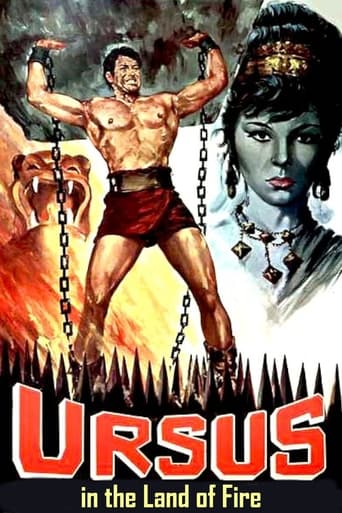Rainey Dawn
General Amilcare (Hamilon) kills King Lotar with the help of the king's niece Mila. Hamilon and Mila take the throne as the new dictator King and Queen. The King wages war on their peaceful neighboring country, killing the woman and kids, enslaving the men. The Queen is torturing her cousin Diana (King Lotar's daughter). Suddenly a hero appears, his name is Ursus. Ursus is captured and enslaved for only for awhile then sentenced to a slow and torturous death but Ursus breaks free. Now Ursus and Lotar will fight in the pits of a volcanic cavern! This is the 3rd film of the Ursus trilogy. It's your standard or typical B-Move Peplum of the time era. I found it a little entertaining at times. The arena scenes are the best, just mindless watching them in their costumes battle then Ursus challenged Hamilon. The ending was OK when the people battled the soldiers and the battles that took place underground in the cavern.3/10
dbborroughs
Actually they are five muscle men tossing make believe rocks but in a run of the mill film of good guy freeing oppressed people you take what you can get.The action is good but the story is average and the same one we've seen in just about every film like this. Worse its paced much too slowly. The dubbing is interesting as voices change depending on whats being said. Its a bland exercise that is best summed up by its semi volcanic eruption- its not quite the spectacle anyone hoped for.
django-1
Made in 1963, URSUS IN THE LAND OF FIRE was Ed Fury's third and final film as Ursus (although there was not much continuity from film to film with the specifics of Ursus' personal details!) and also Fury's final peplum film in the 1960's. Filmed in rich pastel colors (blue seems to be a favorite color in many scenes) and featuring fascinating and imaginative set designs throughout, the film is an above average peplum in every way. As another critic noted, the series of tests and physical challenges for Ursus are ingenious and require Fury to display his strength and physique to their best advantage. The sequence where he shows up at a tournament run by the evil ruler and then stands up to the evil one AND whips everyone who takes him on is very well-staged and exciting. Co-writer Luciano Martino has many strong credits as producer and/or writer in sword-and-sandal, westerns, giallo, and 70s crime films including a number of cult classics. Director Giorgio Simonelli went on to direct a number of Franco and Ciccio comedies--his previous peplum work as a writer includes two Brad Harris classics (Samson and The Fury of Hercules) as well as the fascinating 1963 horror film TOMB OF TORTURE aka METEMPSYCHO. This film may well be Ed Fury's best starring vehicle and is probably the film I would show someone I wanted to convince of Fury's status as a major peplum star. The US television print I taped off UHF in the early 1990s isn't really pan-and-scan--it's as though the outer two-thirds of the picture are just lopped off and you are watching the middle-third. The credits are hard to read as you only get the end of the first name and the beginning of the second name! As I've said about many other peplums, this cries out for a sharp, letterboxed DVD transfer. With this film's rich visuals, beautiful photography, and interesting set design, it's well worth tracking down for any sword-and-sandal film devotee.
dinky-4
Having heard good things about this sword-and-sandal movie, I found myself a tad disappointed with some of its aspects, but in general, this is superior to most of its competition and "Hercules" fans will find it well worth a look. Of particular note are several of the imaginative and impressive indoor sets which are a clear cut above the plywood-columns sort of decorating one often sees in this genre. Of course, any "Hercules" movie must largely be judged on the appearance and appeal and talents of its main actor, and here we're fortunate to have Ed Fury, who not only looks good with his shirt off but who has some personal flair as well. He plays the part with an agreeable touch that's a welcome break from the "grimly determined muscleman" school of acting. Another way of judging these movies lies in the quality of the tortures which are inflicted on the hero. Here, we have two good ones. In the first, Fury is chained to one of those wooden poles which protrudes from a circular grist-mill. "Encouraged" by a burly overseer who lashes him across his bare back, Fury must walk around in a circle, pushing that pole and turning that grist-mill. (And boy, is this a big grist-mill!) Unlike other such sequences, such as that involving Victor Mature in "Samson and Delilah," this horizontal pole is not at waist level but rather positioned above Fury's head so that his chained arms are extended upward from his body. This seems to make the ordeal even more strenuous and painful and effectively showcases Fury's physique. In the second torture, he's forced to stand on a dungeon floor amid a number of sharp metal spikes which protrude upward. He's also forced to hold above his head an enormous flat stone. Eventually his arms will weaken and the weight of that stone, pressing inexorably downward, will impale him on those spikes just before it crushes him. The appeal of this torture is that it turns the hero's chief asset -- his strength -- against him. The longer he's able to hold up that stone, the more he prolongs his agony. And in the process, of course, the more entertainment he provides for his captors -- and for the movie audience as well!


